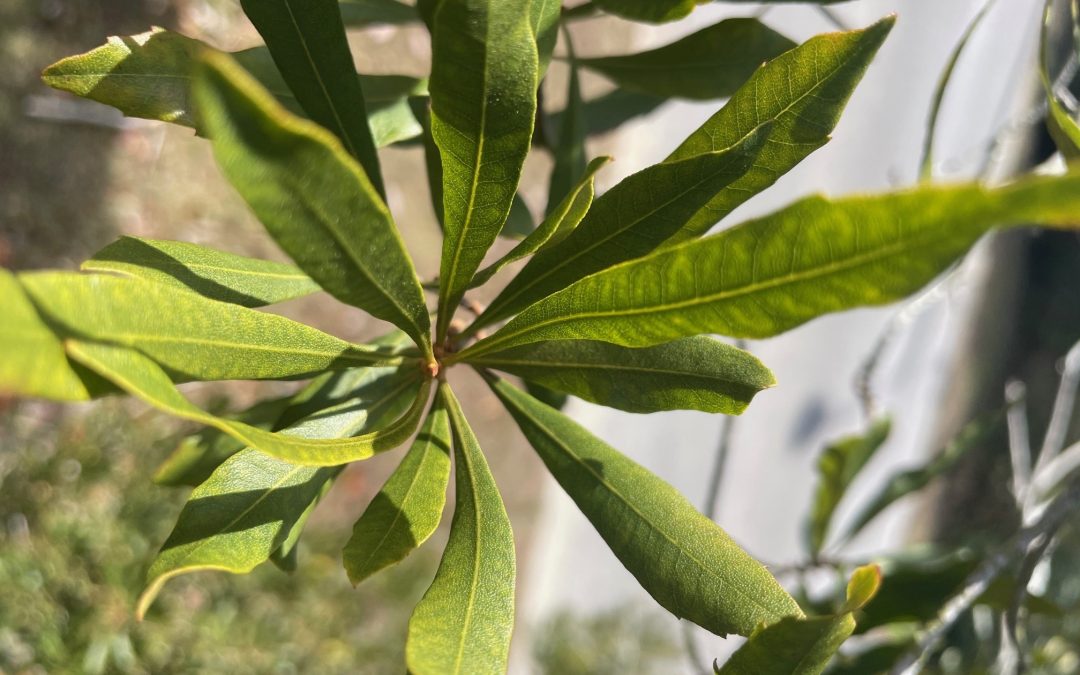
by Carrie Stevenson | Dec 26, 2025

Wax myrtle is an evergreen shrub found commonly along the edges of wetlands. Photo credit: Carrie Stevenson, UF IFAS Extension
Wax myrtle (Myrica/Morella cerifera) is one of those evergreen shrubs that mostly lives out its life in the background. Neither tall and imposing (on average, up to 12’; rarely as tall as 20’), nor full of showy flowers, it is nonetheless an important native species. Behind that low-key persona is a small tree that has played numerous roles in American history. Also known as bayberry, wax myrtle grows in low-lying areas along the edges of wetlands. It is a fast grower and will fill in open spaces if there is enough available light. Wax myrtle is a hardy plant, highly tolerant of salt, and works well in pollinator gardens and urban locations. Both male and female plants are necessary to produce numerous berries, which grow directly on the plant stem. A wide variety of birds use the plants as nesting areas and feed on the berries, including warblers, swallows, wrens, and turkeys.

Wax myrtle shrubs play an important role in feeding and roosting for birds. Photo credit: Carrie Stevenson, UF IFAS Extension
People have long planted wax myrtle shrubs as natural privacy screens, or used an extract from the leaves as a mosquito repellent. The leaves are tough, similar in texture to live oaks, helping hold in water for drought tolerance and keep out salt, enabling them to thrive in coastal areas.
The leaves and berries serve several useful purposes for humans. Native American tribes, particularly the Seminoles in Florida, would use fermented leaves as a medication for headaches and fevers. The berries are a greenish gray/blue color and are the size of BB’s. Each shrub can grow hundreds of small berries along each branch, and berries have a waxy coating that will separate from the berry flesh when boiled.
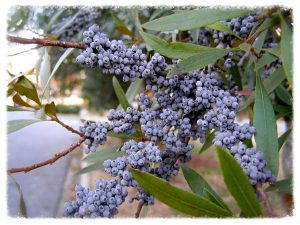
A wax myrtle plant loaded in its small, waxy berries. Photo from Creative Commons.
Early American settlers would collect this wax and reform it into bayberry candles. They would serve a dual purpose in providing both light and mosquito protection. In those early days, mosquito-borne diseases like yellow fever and malaria were both common and deadly, so it was a matter of survival. The plants have also been used to deter fleas and cockroaches.
According to several native plant enthusiasts who posted bayberry-candle-making videos on YouTube, the rule of thumb is that you’ll need to collect a gallon of wax myrtle berries to create a cup of wax. Besides candles, early settlers also used the wax for soap, sealing wax, and shaving cream. Be mindful that wax myrtle plants are flammable, so it is recommended that if planted in a home landscape, they are in an area safely away from the building walls.
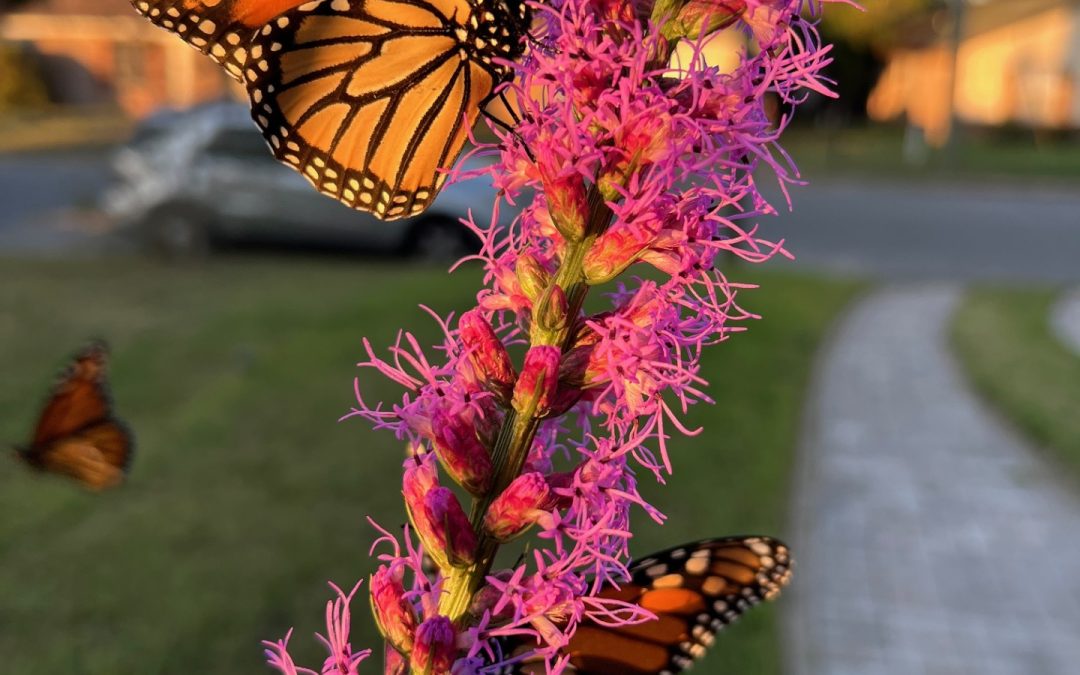
by Carrie Stevenson | Nov 6, 2025

A spectacular array of blazing star in bloom. Photo credit: Troy Springer, Florida Wildflower Foundation
Walking through a northwest Florida wildflower prairie in autumn, the star of the show is Liatris. Known as dense gayfeather or blazing star, this tall (up to 7’!) stunner of a plant is covered up with clusters of small purple flowers. The flowers are are composed of tiny, frilly five-petaled florets. Each cluster may have groups of up to 18 flowers at a time, crowding the stalk with color.
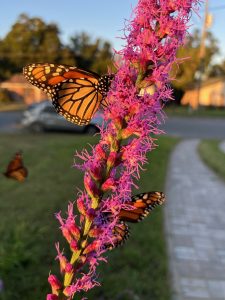
Migrating monarchs feed on blazing star in late fall. Photo credit: Whitney Scheffel
Before blooming, the spiky grasslike structure grows upright and produces a series of dozens of green leaflets, similar in form to rosemary.
While delicate in appearance, the blazing star is a hardy plant adapted to a wide range of habitats. Some varieties can grow in the pure sand of beach dunes and scrub, while Liatris spicata thrives in the soggy wet soils of bogs and pine flatwoods. The species is known for attracting bees, butterflies, and hummingbirds, so it makes a great addition to a pollinator garden. The flowers perform best in full sun.
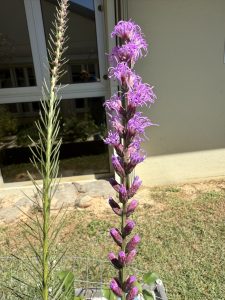
Side-by-side, the bottlebrush-like blazing star plant before and after blooming. Photo credit: Carrie Stevenson, UF IFAS Extension
Blazing star is particularly impressive in a large group, so you can plant dozens together (by seed or container) for a beautiful effect. After blooming deep purple this time of year, they’ll turn a goldish bronze that adds to the interesting fall color of a garden. Liatris will also re-seed every year after dying back in the winter.
There are many plants native to the United States known commonly as colic root, including blazing star. This nickname arose from its traditional medicinal use treating stomach cramps. Additional uses of a tea made from the plant were used for everything from sore throats and kidney issues, while an incense made from dried roots was burned for sinus relief.

by Carrie Stevenson | Oct 3, 2025

A typical katydid, with remarkable leaf-like camouflage. Photo credit: Carrie Stevenson, UF IFAS Extension
The intricate camouflage developed within the animal kingdom never fails to fascinate me. From fish that look like seagrass blades to butterflies that look like tree bark—or a pair of eyes—the variety, color, and textures are just mind-boggling. Among those are the leaf bugs, or katydids, that flawlessly evoke natural foliage. I had one join me on a patio chair recently, and I couldn’t stop starting at the detailed venation on their wings, which perfectly mimicked the veins on a leaf.
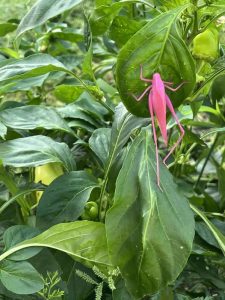
One of the pink katydids on display at the Audubon Insectarium. Photo credit: Amy Pitre courtesy LSU AgCenter
There are well over 6,000 species of katydids, and they’re found on every continent but Antarctica. Related to crickets and grasshoppers, they are similar in that they are remarkable jumpers, with strong hind legs that can also produce recognizable scraping, buzzing, and trilling sounds. The insects got their name from the perception that the noises they produce sound like, “Katy did!, Katy didn’t!” which are primarily made by males of the species. Song production and recognition among katydids are highly developed, used for warnings, attracting mates, or defending territory. Katydids detect sounds by raising their front legs, which have sensing/hearing patches called tympanum. Katydid and cicada songs can be differentiated by timing—cicadas trill during the day, while katydids are active at night.
Katydids have antennae nearly as long as their bodies, and despite their large wings are not strong flyers. Every katydid I’ve ever seen is a leafy green color, blending perfectly into its surroundings and hiding in plain sight from avian predators. However, they come in several different colors, including tan, yellow, orange, and hot pink. I cannot fathom how hot pink is an effective adaptation, but they are occasionally found—at a rate of 1 in 500—in the wild. The pink coloration is due to a genetic condition called erythrism, which is similar to the recessive traits causing albinism. New Orleans’ Audubon Insectarium exhibits several pink katydids, which, with no natural predators, can live typical katydid lifespans.
Katydids are found widely in the state and can be a pest of citrus, but are not considered a major issue. In a home garden, they are generally considered beneficial. While they might nibble on plant parts, they also feed on pest insects like aphids and can aid in pollination.
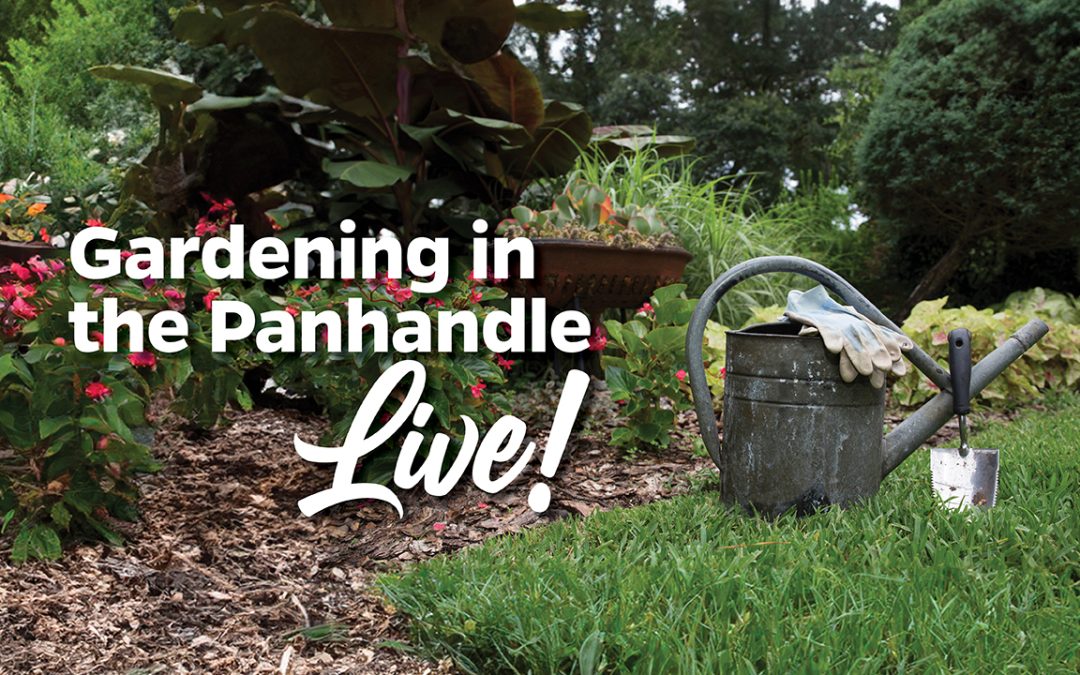
by Julie McConnell | Sep 18, 2025
 Last month we focused on the 2025 Great Southeast Pollinator Census and how Florida residents and visitors could join in this citizen scientist project. Since this was only the second year Florida participated, we knew you would have lots of great questions!
Last month we focused on the 2025 Great Southeast Pollinator Census and how Florida residents and visitors could join in this citizen scientist project. Since this was only the second year Florida participated, we knew you would have lots of great questions!
Below is a recap of your inquiries and any references the panelists shared in case you wanted to dig deeper into the topic.
What is the Great Southeast Pollinator Census (GSEPC) and what is the data used for?
The pollinator census brings awareness of pollinators, encourages people to create habitat, and collects information that can be used to create baseline numbers and compare the population growth or decline over time.
How to identify bees, wasps, and other pollinators I see?
Luckily, you do not have to identify these insects to species – you only have to classify them into broad categories. Resources to help you spot key characteristics can be found here:
Bees of Florida
Pollinator Census Google Site
What time of day should I count?
Mornings and evenings are a great time to count because it is comfortable for the counter but also consider that time of day will affect the insects seen. For instance, many moths and beetles are active at night while honey bees are active during the day. Basically, there is no wrong time to count!
Will we be able to indicate which plants and whether or not they are native or non-native?
The GSEPC count sheet has a place for the plant name you are observing which can be common or scientific. There is not a designation on the form for native/non-native but if you use the scientific name that is easy to check when data is available.
Great Southeast Pollinator Census Counting Sheet
How to best encourage neighbors to get involved?
Print off some extra count sheets and invite people to join you or host a pollinator party!
What can we do to increase pollinators in our yards?
Provide nesting habitats for native pollinators such as undisturbed bare ground, hollow stems, small debris piles, and pollinator hotels. Be sure to maintain pollinator hotels to encourage use.
Responsible use of pesticides – always read labels and avoid products with pollinator warnings.
Pollinator Hotels
Plant diverse flowering plants to provide pollen and nectar and provide water resources.
Simple Steps to Create a Pollinator Paradise in Your Landscape
Provide Water for Pollinators
Are bumble bees a protected species?
There are almost 50 different bumble bee species in the United States, and not all live in Florida. Two are listed as protected species, one that occurs in Oregon and another in the Central Plains and may be in our area. The common species we see in Florida, American Bumble Bee and Eastern Bumble Bee are not currently listed as protected or endangered. Find a Species | U.S. Fish & Wildlife Service
Resources for Schools and Home Schools
Some public libraries have “Seed Libraries” and give out seed which may be appropriate for pollinators.
Seedlings for Schools Grants
Panelists favorite flowers for bees and other pollinators:
Abbey – purple coneflower and other Echinacea, Black-eyed Susan, Zinnia, Coreopsis
Beth – buttercup, goldenrod
Mark – yarrow, Stoke’s Aster (native to FL), Vitex agnus-castus Chaste Tree
Daniel – Vitex, Blue butterfly Clerodendrum, Firebush
Anything in the Aster Family!
Balance of controlling pests in vegetable garden but still welcoming pollinators.
Be tolerant of damage! Regardless of your tolerance level of damage be sure to use Integrated Pest Management strategies which may include trap crops, cover crops, and scouting regularly so you can catch pests early and hand pick when possible. If a pesticide is needed, use very specific targeted products such as Bt, soaps, or oils instead of broad-spectrum pesticides. (Always ensure products are listed for use on vegetable gardens and follow labels). Pesticide Labeling – A Guide to Users
Do you need a license to keep honey bees?
A license is not required; however, all bee hives must be registered with the Florida Department of Agriculture and Consumer Services (FDACS).
Beekeeper Registration– Florida Department of Agriculture and Consumer Services
UF/IFAS Research and Extension Honey Bee Lab has great resources for beekeepers!
If you missed this or other episodes be sure to check out our YouTube Playlist
by Carrie Stevenson | Aug 9, 2025
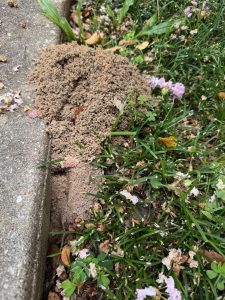
A cicada killer burrow at the Escambia County Extension Office. Photo credit: Carrie Stevenson, UF IFAS Extension
The other day, our Horticulture agent, Beth Bolles, called me over to point out something of interest. Along the sidewalk between our buildings was a sandy burrow that looked like a cross between a fire ant mound and a crawfish burrow. “People ask me about these all the time—you may want to write about them,” she said. Sure enough, just a couple days later I was tagged in a Facebook photo asking if I knew what this weird sandy mound was.
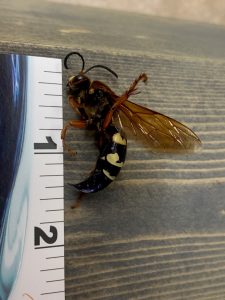
An up-close photo of a cicada killer brought into our office for identification. Photo credit: Beth Bolles, UF IFAS Extension
What Beth pointed out was the burrow of a cicada killer (Sphecius speciosus) wasp, also called the great ground hornet. Cicada killers are large (among the largest in the country, at 1.5-2” long) ground-dwelling wasps that use cicadas for an important part of their life cycle. They can fly, but I have observed them crawling through low weeds and grass. They have black bodies and wings with brilliant yellow stripes on their abdomens, and adults feed on flower nectar.
These wasps’ reproductive cycle is rather fascinating. After males and females emerge from the soil in the summer, they mate while in flight. Females then dig the burrows, using their front legs to scrape soil out of the ground and kick it out with their hind legs. Burrows may be up to 4 feet deep, with branches and larger cells.
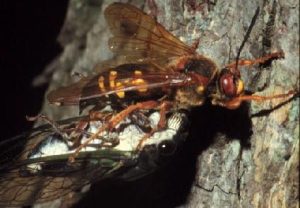
A female cicada killer with her cicada prey. Photo credit: North Carolina State University Extension
Future moms then seek out cicadas, which they sting and paralyze on the leg. The wasps drag cicadas on their backs and into their underground burrows. They place 1-4 cicadas in each cell, depending on insect size. Once this task is completed, the females lay eggs—one into each cicada body. The sex of their offspring can be determined by placement, with the more substantial cicadas implanted with future females, who will need the extra energy. Female cicada killers have been observed to share their burrows with as many as 3 other wasps.
While female wasps stay busy with reproduction and burrowing, the males primarily serve roles of protection and competition for mates. Male cicada killers are known to “invade personal space” of humans by hovering at eye level, and can seem aggressive. However, they are harmless—only the females have stingers!
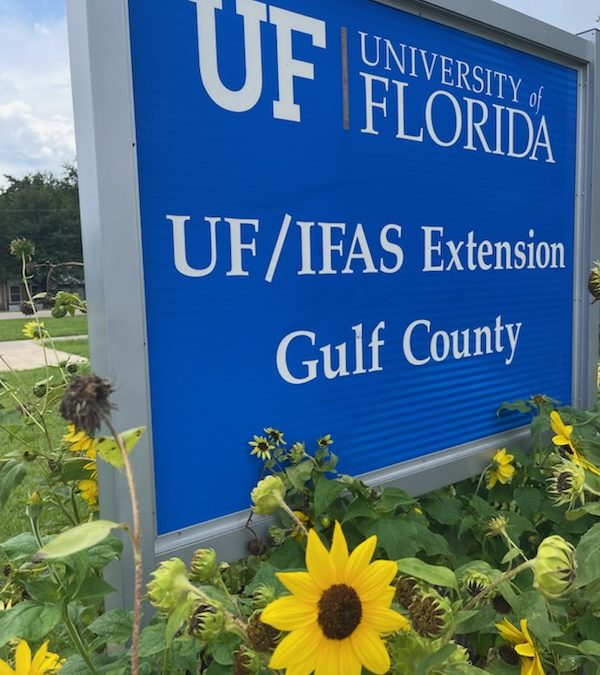
by Ray Bodrey | Jul 20, 2025
Sunflowers, Helianthus spp., are a great choice for gardeners who are looking for some cheerful color in their landscape. Here in Florida, we have the main ingredient for success, lots of sunshine!

Skyscraper Sunflower. Credit: Ray Bodrey, UF/IFAS Extension.
Sunflowers are short-lived annuals. A good average time between planting and bloom is roughly 65 days. You can typically plant sunflowers in Florida beginning in late winter until early fall. Only the coldest months are the issue, and for most years that’s only a couple of months for us. Sunflowers can be planted almost anywhere there is full sun. The major selling point to plant sunflowers is of course the impressive blooms (figure 1). These yellow to sometimes orange or red petaled flowers develop a central seed disc, with most varieties having approximately an 8” diameter in growth.
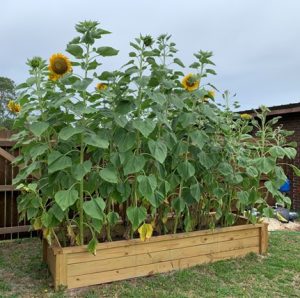
Skyscraper sunflowers planted in close pattern. Credit: Ray Bodrey, UF/IFAS Extension.
As for planting, you may choose to plant narrow rows and close seed spacing in order to cull less preforming plants later. A final row and seed spacing of 2’-3’ is recommended for full height and development of most varieties. However, you may choose to plant in a bed, using a close pattern as seen in figure 2. In any event, sunflowers are easy to propagate by seed and are very low maintenance. However, powdery mildew and spittle bugs can be a nuisance. A general garden fungicide and insecticide will help if problems occur.
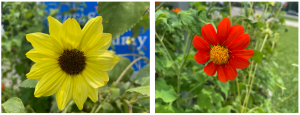
Sunflowers, Helianthus spp. Credit: Ray Bodrey, UF/IFAS Extension.
Sunflowers are available in many varieties, which consists of different color blooms and plant sizes. These sizes range from dwarf (1’-3’) to tall (10’-15’) varieties (figure 2). You may wish to stake taller varieties at some point, as some plants will tend to lean with no wind break in place. Here’s a few gardening variety common names to look for: sunbright, sonja, sunrich lemon or orange and autumn beauty. Seed companies also have mixes available in packets. For tall plants, mammoth or skyscraper varieties exist.
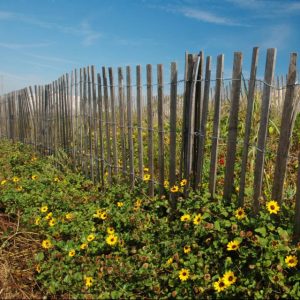
Beach sunflower. Credit: Ralph Mitchell, UF/IFAS Extension.
If you are fond of the sunflower bloom and looking for a groundcover, there are a couple of native perennials that fit this category. Beach sunflower, Helianthus debilis or swamp sunflower, Helianthus angustifolius, are groundcovers/ornamentals for landscapes and thrive in dry, hot climates and in a range of soil types. They also are great pollinator attractors.
For more information, contact your local county extension office. Happy Gardening!
Supporting information for this article and links to other publications can be found at the UF/IFAS Gardening Solutions website: https://gardeningsolutions.ifas.ufl.edu/plants/ornamentals/sunflowers.html
UF/IFAS Extension is an Equal Opportunity Institution.




















